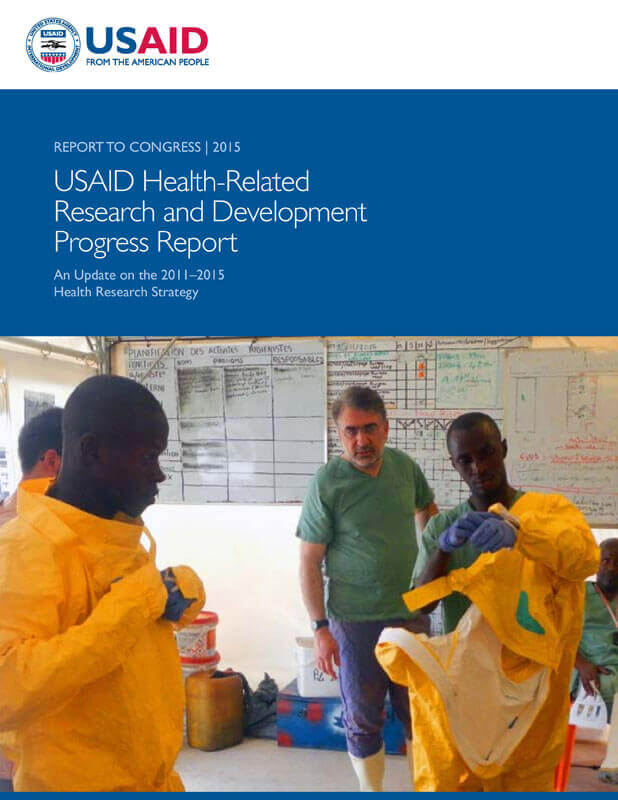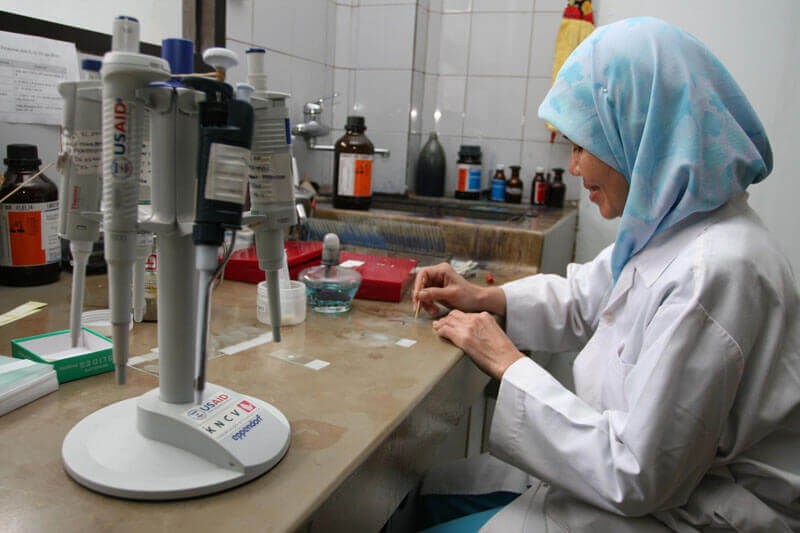 USAID's 2015 Health-Related Research and Development Progress Report. Photo: USAIDLast month the US Agency for International Development (USAID) released its annual Health-Related Research and Development Progress Report detailing the agency’s research and development (R&D) activities to
address global health challenges.
USAID's 2015 Health-Related Research and Development Progress Report. Photo: USAIDLast month the US Agency for International Development (USAID) released its annual Health-Related Research and Development Progress Report detailing the agency’s research and development (R&D) activities to
address global health challenges.
Breakthroughs Blog is joined by Neal Brandes—team leader for USAID’s Health Research Program (HaRP) in the Bureau for Global Health—to
learn more about the report and USAID’s ongoing support for global health R&D. The HaRP team coordinates the cross-bureau effort to produce this
publication and has been advocating collaborative and coordinated research and research utilization efforts to accelerate the research-to-use process.
Q: GHTC is always excited to dig into this great report each year. Can you highlight for our readers what is new in this year’s report with regard to new programmatic developments at USAID or major scientific developments in USAID-supported biomedical R&D?
NB: There are many new developments that we’re excited about in this year’s report. To highlight just a few:
- The Ebola epidemic this past year emphasized the need for processes to solicit new ideas and rapid solutions based on sound evidence. This year’s report
highlights the exciting products of the Fighting Ebola Grand Challenge, as well as the ongoing good works to produce innovations through the Saving
Lives at Birth Grand Challenge.
- On the newborn front, we report on the progress on care of newborns with possibly severe infection or sepsis—one of the leading preventable causes
of death. The World Health Organization (WHO) recommends that sick newborns be referred to hospitals for in-patient care, but also recognizes there
are significant barriers to families in low- and middle-income settings accessing that essential care. A multicountry and multidonor initiative
supported research establishing that newborns unable to access hospital care can be treated by a trained health worker in lower-level health facilities.
This treatment is provided on an outpatient basis with a shorter course of antibiotics. The WHO has recently updated its guidance based upon this
new evidence, and we are already in the midst of implementation research to test, adapt, and support its effective and safe application in real-world
health systems.
- Finally, there was encouraging progress on research to combat the HIV and AIDS epidemic. Findings from two dapivirine ring trials are highlighted. These
are landmark studies because they are the first to test the efficacy of a woman-controlled method of HIV prevention that uses a nongel microbicide.
Q: This year’s report marks the end of USAID’s 2011–2015 Health Research Strategy. Looking back at the last five years of USAID-supported biomedical R&D, what are some of the most exciting and impactful developments or innovations that have resulted? Are there disappointments or areas in which not as much progress was made as the agency had hoped?
NB: Research operates across a continuum. Fortunately, in recent years we’ve had the opportunity to witness some of these efforts come to fruition. For
example, take the chlorhexidine story. Chlorhexidine was an early effort to invest in a promising idea through a managed research-to-use process. We
began with a careful assessment and then a modest series of concurrent proof-of-principle studies; research utilization efforts; and collaborative
efforts with governments, universities, nongovernmental organizations, and pharmaceutical companies that demonstrated the potential and established
a foundation to save lives. Nepal was both an early adopter and a global champion for the results of this work. Today these efforts have led to global
engagement, rigorous introduction, and scale-up planning in 10 countries.
We also understand that the nature of research involves uncertainty and planning for failure. Because of the commitment of our partners and the agency’s
culture of learning, we are able to see setbacks as opportunities to improve our processes and extract value from our missteps that will improve the
next efforts to address complex challenges.
Q: The report illustrates how USAID is working with other US agencies across the continuum of R&D to develop new tools to combat tuberculosis (TB) as part of the US government TB strategy. Could you tell us more about how USAID is coordinating with other US agencies to advance development of critically needed tools in other health areas?
 A lab technician test tuberculosis samples at a lab in Bandung's Public Health Laboratory. Photo: USAID IndonesiaNB: We work with many stakeholders, foremost of which are the host governments. Because we are stewards of the public’s money, we collaborate with US government
agencies as well as other donor development agencies such as the United Kingdom Department for International Development and philanthropies on almost
every area of our portfolio—whether it’s to keep each other informed to ensure our efforts are aligned and coordinated or coordinating cofunding
to advance the R&D agenda with a goal of advancing research investments to save lives. For example, our malaria portfolio consists of many operational
research projects that are done through the President’s Malaria Initiative—a joint effort between USAID and the US Centers for Disease Control
and Prevention (CDC). The Ebola Grand Challenge efforts were based on a coordinated partnership with USAID, the White House Office of Science and Technology,
CDC, and the US Department of Defense. To introduce new tools and measurements in behavior science (like Big Data), we are working with the White House
Social and Behavior Science team.
A lab technician test tuberculosis samples at a lab in Bandung's Public Health Laboratory. Photo: USAID IndonesiaNB: We work with many stakeholders, foremost of which are the host governments. Because we are stewards of the public’s money, we collaborate with US government
agencies as well as other donor development agencies such as the United Kingdom Department for International Development and philanthropies on almost
every area of our portfolio—whether it’s to keep each other informed to ensure our efforts are aligned and coordinated or coordinating cofunding
to advance the R&D agenda with a goal of advancing research investments to save lives. For example, our malaria portfolio consists of many operational
research projects that are done through the President’s Malaria Initiative—a joint effort between USAID and the US Centers for Disease Control
and Prevention (CDC). The Ebola Grand Challenge efforts were based on a coordinated partnership with USAID, the White House Office of Science and Technology,
CDC, and the US Department of Defense. To introduce new tools and measurements in behavior science (like Big Data), we are working with the White House
Social and Behavior Science team.
Q: Why is it important for USAID to continue to play a strong role in health research, and what’s next for USAID in this area? Should we expect a 2016–2021 strategy, and how might it look similar to or different from the current strategy?
NB: We still have many health challenges ahead of us, and our success is dependent on garnering strong evidence to inform decision-making and action. USAID
has the advantage as a development agency to provide technical leadership and an on-the-ground presence working in conjunction with our partner countries
and other stakeholders to accelerate the application and development of science and innovation.
We are actively discussing our new research strategy. Like our previous strategies, it will address the unique needs of each of our technical areas. However,
we are also working together to articulate a number of broad principles that define our work—placing emphasis on how our work includes implementation
science, innovation, and partnerships.


